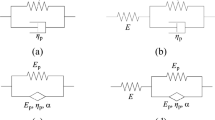Abstract
In this study, a new nested model consisting of springs and “spring pots” is proposed to better simulate the viscoelastic behavior of polymeric damping materials in the frequency domain. First, the one-dimensional constitutive equation that consists of ten parameters is derived. The dynamical mechanical properties, which are the storage modulus, the loss modulus, and the loss factor, are obtained from this equation. Then, the low- and high-frequency behavior of this model is investigated. Moreover, a new methodology to identify the unknown parameters that appear in the fractional derivative model, from the experimental data for the Wicket plot, by using genetic algorithms (GAs) is presented. This approach does not require shifting of the experimental data; therefore, possible errors that may arise are eliminated. The new model is fitted to experimental data for several polymeric damping materials that exist in the literature, in order to verify its success. The results are presented in a graphical form with comparison to the already existing models.










Similar content being viewed by others
References
Bagley RL, Torvik PJ (1983a) Fractional calculus—a different approach to the analysis of viscoelastically damped structures. Aiaa J 21(5):741–748. doi:10.2514/3.8142
Bagley RL, Torvik PJ (1983b) A theoretical basis for the application of fractional calculus to viscoelasticity. J Rheol 27(3):201–210. doi:10.1122/1.549724
Bagley RL, Torvik PJ (1986) On the fractional calculus model of viscoelastic behavior. J Rheol 30(1):133–155. doi:10.1122/1.549887
Blair GWS (1947) The role of psychophysics in rheology. J Colloid Sci 2(1):21–32
Caputo M, Mainardi F (1971) New dissipation model based on memory mechanism. Pure Appl Geophys 91(8):134–147. doi:10.1007/bf00879562
Dinzart F, Lipinski P (2009) Improved five-parameter fractional derivative model for elastomers. Arch Mech 61(6):459–474
Drake ML (1989) Damping properties of various materials. Air Force Wright Aeronautical Laboratories, Dayton
Fan BF, Kazmer DO (2005) Low-temperature modeling of the time-temperature shift factor for polycarbonate. Adv Polym Tech 24(4):278–287. doi:10.1002/Adv.20049
Ferry JD (1980) Viscoelastic properties of polymers, 3rd edn. Wiley, New York
Friedrich C (1991) Relaxation and retardation functions of the maxwell model with fractional derivatives. Rheol Acta 30(2):151–158. doi:10.1007/bf01134604
Friedrich C, Braun H (1992) Generalized Cole-Cole behavior and its rheological relevance. Rheol Acta 31(4):309–322. doi:10.1007/bf00418328
Galucio AC, Deu JF, Ohayon R (2004) Finite element formulation of viscoelastic sandwich beams using fractional derivative operators. Comput Mech 33(4):282–291. doi:10.1007/s00466-003-0529-x
Glockle WG, Nonnenmacher TF (1991) Fractional integral-operators and fox functions in the theory of viscoelasticity. Macromolecules 24(24):6426–6434
Gray F (1953). Pulse code communications. U.S. Patent 2632058, 17 March 1953
Heymans N (1996) Hierarchical models for viscoelasticity: dynamic behaviour in the linear range. Rheol Acta 35(5):508–519
Heymans N, Bauwens JC (1994) Fractal rheological models and fractional differential-equations for viscoelastic behavior. Rheol Acta 33(3): 210–219. doi:10.1007/bf00437306
Jaishankar A, McKinley GH (2013) Power-law rheology in the bulk and at the interface: quasi-properties and fractional constitutive equations. P Roy Soc a-Math Phy 469(2149):20120284. doi:10.1098/Rspa.2012.0284
Jones DIG (2001) Handbook of viscoelastic vibration damping. Wiley, Chichester
Kaelble DH (1985) Computer-aided design of polymers and composites. Plastics engineering, vol 7. M. Dekker
Lewis T, Nashif AD, Jones DIG (1989) Frequency-temperature dependence of polymer complex modulus properties. In: Proceedings of damping ’89. West Palm Beach, Florida
Nutting PG (1921) A new general law of deformation. J Frankl Inst 191:0679–0685. doi:10.1016/s0016-0032(21)90171-6
Oyadiji SO, Tomlinson GR (1991) Establishing the validity of the master curve technique for complex modulus data reduction. In: Proceedings of damping ’91. San Diego, California
Pritz T (2003) Five-parameter fractional derivative model for polymeric damping materials. J Sound Vibr 265(5):935–952. doi:10.1016/s0022-460x(02)01530-4
Rowe GM, Sharrock MJ (2011) Alternate shift factor relationship for describing temperature dependency of viscoelastic behavior of asphalt materials. Transport Res Rec 2207:125–135. doi:10.3141/2207-16
Schiessel H, Blumen A (1995) Mesoscopic pictures of the sol-gel transition—ladder models and fractal networks. Macromolecules 28(11):4013–4019. doi:10.1021/ma00115a038
Sharma R, Cherayil BJ (2010) Polymer melt dynamics: microscopic roots of fractional viscoelasticity. Phys Rev E 81(2). doi:10.1103/PhysRevE.81.021804
Soovere J, Drake ML (1985) Aerospace structures technology damping design guide. Volume III—damping material data. Air Force Wright Aeronautical Laboratories, Dayton
Tschoegl NW (1989) The phenomenological theory of linear viscoelastic behavior: an introduction. Springer, Berlin
Author information
Authors and Affiliations
Corresponding author
Appendix
Appendix
The open form of the loss factor relation of ten-parameter model is as follows:
The one-dimensional constitutive equation of the ten-parameter model, which can be derived from inverse Fourier transform of Eq. (19), is as follows:
where D is the fractional differentiation operator in Caputo sense, which can be expressed mathematically as follows:
Rights and permissions
About this article
Cite this article
Arikoglu, A. A new fractional derivative model for linearly viscoelastic materials and parameter identification via genetic algorithms. Rheol Acta 53, 219–233 (2014). https://doi.org/10.1007/s00397-014-0758-2
Received:
Revised:
Accepted:
Published:
Issue Date:
DOI: https://doi.org/10.1007/s00397-014-0758-2




